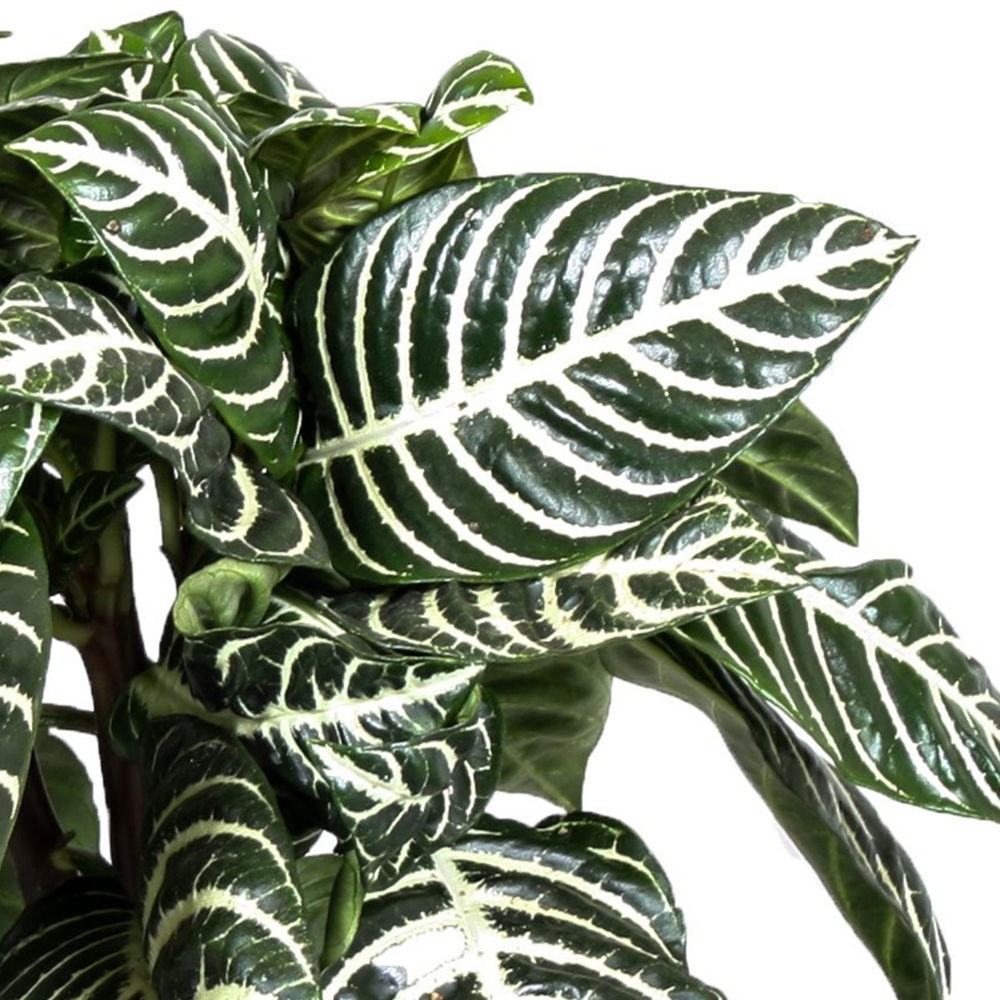
Aphelandra squarrosa - Copyright: Gardeners' Dream
Contents
- Top Tips
- Location, Water, Humidity & Fertilisation
- Dormancy Period & Achieving Flowers
- Common Issues
- Origins, Temperature, Propagation, Repotting & Toxicity.
Need the answer to a specific plant query? Book a 1-to-1 video call with THE HOUSEPLANT DOCTOR™, the website's friendly author to overcome and address your niggling problem! Available on iMessage, WhatsApp, Facebook Messenger & more.
Top Tips & Info
- Care Difficulty - Moderate
- Aphelandra like bright, indirect light away from excessively dark situations. Although an hour or two of direct sunlight in the early morning is accepted, be sure not to fall in the trap of sun-scorch and dehydration.
- Provide near-constant moist soil, allowing the soil's top third to dry out in between waters. Reduce irrigations slightly further in the height of winter.
- Supplement at monthly intervals all year round, using a houseplant-labelled fertiliser to ensure quality foliage and flower development.
- Fertilise using a 'Houseplant' labelled feed every third water, all year round.
- Keep an eye out for Spider Mites & Mealybugs that'll hide in the plant's cubbyholes and underneath the leaves.
- Unfortunately, Aphelandra usually only last a few years due to the species' tendency to die shortly (a year or two) after flowering. This is one of the reasons why finding them in garden centres is difficult, as the eventual death results in disappointment.
- In the 'Dormancy Period & Achieving Flowers' section, familiarise yourself with the terms, 'bracts' and 'flowers' that make up the specimen's blooms.
Location & Light - 🔸🔸
Aphelandra prefer to be sat in medium light with the absence of deep shade. As you'll have to keep the soil relatively moist, the risk of soil mould and over-watering is considerably increased when maintaining too little light.
Once the autumn kicks in, be sure to include an hour or two of direct light per day to get it through the dormancy period, lasting until the following spring. Remember - acute exposure to the sunlight during the spring or summer of more than an hour will negatively affect the plant.
Water - 🔸🔸🔸
Aphelandra are best kept in reliably moist soil, as inconsistent moisture levels may result in stunted growth and an unhappy plant. Allow the compost's top third to dry out in between waters in the growing period, reducing this further in the autumn and winter. Under-watering symptoms include a shrivelled stem, yellowing leaves, stunted inflorescences, little to no growth and dry, crispy patches forming on the leaf edges. These issues are usually caused by too much light/heat or forgetfulness. Remember, the brighter the location, the more watering you'll need to do. Over-watering symptoms include a weakened or rotten stem, no new growth, yellowing lower leaves and eventual plant death. Click here to learn more about root rot and how to address it!
Humidity - 🔸🔸🔸
Create a humidity tray to provide a moist and stable environment for your plant. If the surrounding saturation is too low or the heat too high, its leaf-tips may start to brown over and curl, especially in direct sunlight. Gently hose the foliage down from time to time to hydrate the leaves and keep the dust levels down.
Fertilisation - 🔸🔸
Fertilise every third water all year round to ensure this plant has the required energy needed to produce its flower and healthy foliage. Although an outdoor 'All-Purpose' fertiliser will still do the job, we'd recommend using a specific 'Houseplant' labelled fertiliser as it'll support the vital thirteen nutrients that this species will need to grow.
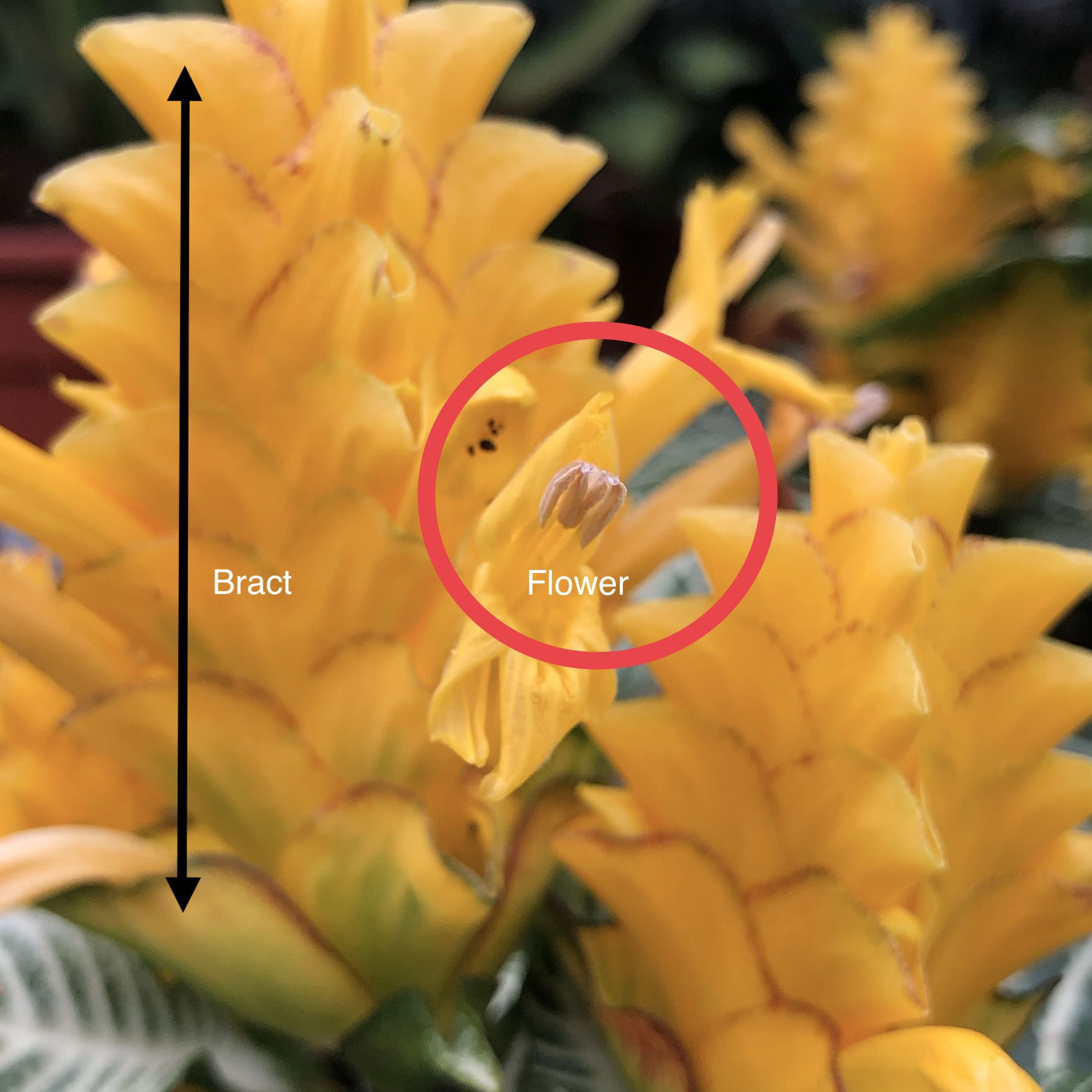 The 'bract' is a modified leaf with the true flower in its axil. In some cases, as shown above, the bract can be much larger than the actual flower, which serves as an advertisement to airborne pollinators.
The 'bract' is a modified leaf with the true flower in its axil. In some cases, as shown above, the bract can be much larger than the actual flower, which serves as an advertisement to airborne pollinators.
Common Issues with Aphelandra
Yellowing lower leaves could be a sign of over-watering, but equally is a byproduct of maturity. If the older leaves rapidly become yellow in quick succession, over-watering could be to blame. People don't realise that a plant's root system needs access to oxygen too; when soil is watered, the air will travel upwards and out of the potting mix. A lack of accessible oxygen for the roots will cause them to subsequently breakdown over the oncoming days. Click on this link to learn more about root rot and how to address it.
If your specimen is located in a dark environment with mould developing on the compost's top layer, use a chopstick to stab the soil in various areas gently. You should aim to enter the compost between the base of the plant and the pot's edge, as failure to do so may lead to damaging its lower portion. Leave the holes open for a few days before re-surfacing the soil to avoid it becoming overly dry. Not only will the gentle shift in the soil's structure mimic the work of small invertebrates in the wild (worms, etc.), but it'll also add oxygen back into the soil, thus reducing the risk of root rot. Repeat this monthly, or whenever you feel the potting-mix isn't drying out quickly enough.
 A steady decline shortly after the flowering period is a natural part of life for Aphelandra. THE HOUSEPLANT DOCTOR™ would recommend increasing the natural lighting slightly, fertilise the plant every three waters and maintain warm temperatures. It's important to accept that this species is likely to only last one or two years after flowering though.
A steady decline shortly after the flowering period is a natural part of life for Aphelandra. THE HOUSEPLANT DOCTOR™ would recommend increasing the natural lighting slightly, fertilise the plant every three waters and maintain warm temperatures. It's important to accept that this species is likely to only last one or two years after flowering though.
Curled leaves and brown leaf-edges are the result of too little water and over-exposure to the sun. Aphelandra are best located in bright, indirect settings, and those that haven't acclimatised to the harsh rays will show signs of sun-scorch and environmental shock. A splash of winter sunlight is acceptable as long as the soil moisture is regularly observed, with complete avoidance once summer comes along.
Never situate it within four metres of an operating heat source, for instance, a heater or fireplace. Due to the heightened temperature, the plant will soak up far more moisture than those situated in cooler locations, increasing the chance of droughts and browning leaf-edges.
Transplant shock is a big issue when it comes to heavy-handed repots. Give the plant a good soak 24hrs before the action and never tinker with the roots, unless it has been affected by root rot. Typical signs of transplant shock are largely similar to under watering, with wilting, yellowing leaves and stunted growth among the most common symptoms. Click here to learn more about addressing transplant shock and a step-by-step guide on performing the perfect transplant.
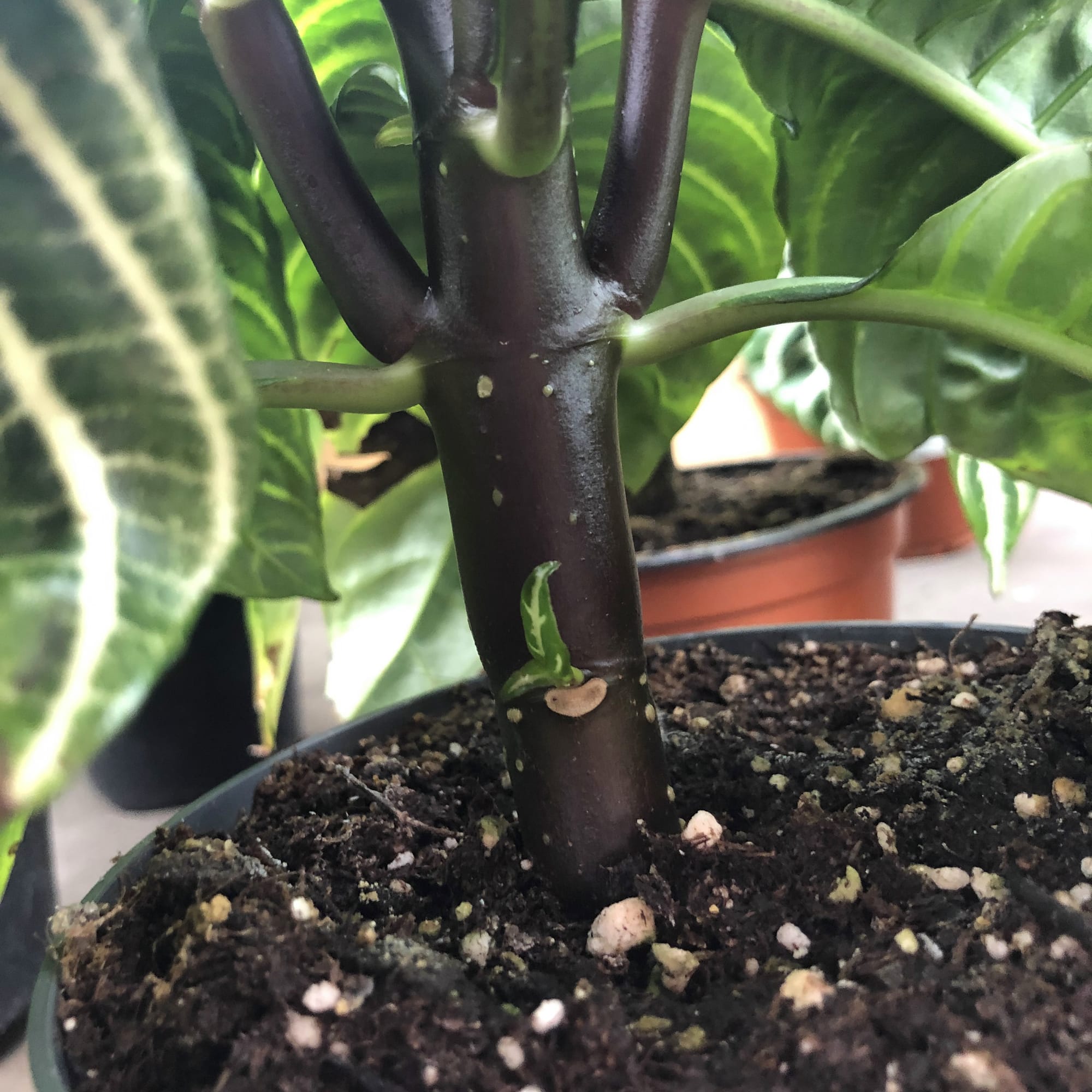 Aphelandra squarrosa has 'opposite' growth, where the two leaves either side of the node grow simultaneously, a similar trait found in Acers.
Aphelandra squarrosa has 'opposite' growth, where the two leaves either side of the node grow simultaneously, a similar trait found in Acers.
Origins
Aphelandra squarrosa was formally classified in 1847 by German botanist, Christian Nees von Esenbeck, during a voyage to South America. At one stage though, it was placed under the genus of Ruellia, for twenty years before finally resting in its current name. Aphelandra refers to the single-celled anthers of the flower, whereas squarrosa describes the square-like positioning of the bracts when fully developed.
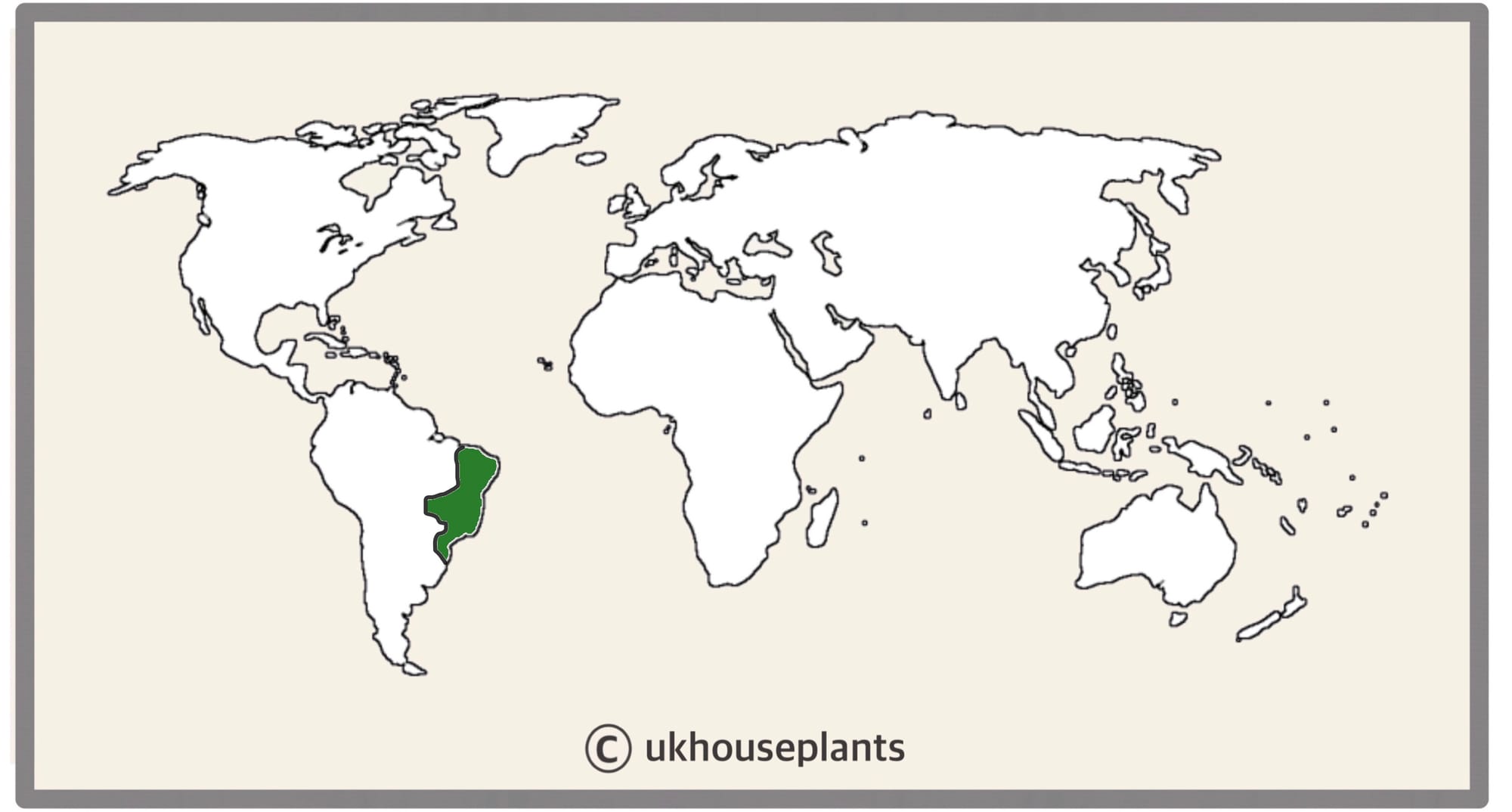 The Distribution of Aphelandra squarrosa.
The Distribution of Aphelandra squarrosa.
Temperature
14° - 27℃ (57° - 80℉)
H1b (Hardiness Zone 12) - Can be grown outdoors during the spring and summer in a sheltered location whilst nighttime temperatures are above 12℃ (54℉), but is fine to remain indoors, too. If you decide to bring this plant outdoors, don't allow it to endure more than an hour of direct sunlight a day as it may result in sun-scorch. Regularly keep an eye out for pests, especially when re-introducing it back indoors.
Spread
The overall size can be up to 1m (3ft) in height and 0.5m (2ft) in width. The ultimate size will take between 2 - 5 years to achieve when repotted every two years, with several new leaves unfurling per annum.
Pruning & Maintenance
Remove yellow or dying leaves, and plant debris to encourage better-growing conditions. While pruning, always use clean scissors or shears to reduce the chance of bacterial and fungal diseases. Never cut through yellowed tissue as this may cause further damage in the likes of diseases or bacterial infections. Remember to make clean incisions as too-damaged wounds may shock the plant, causing weakened growth and a decline in health.
Propagation
Via Seed or Stem Tip Cuttings.
Stem Tip Cuttings (Moderate) - This method is an easy way to duplicate the original plant. Stems that are at least 10cm (4 inches) in height and part of an established plant are most successful. To avoid making a mess of the serrations, use a clean pair of scissors and cut 8cm down from the stem's end, dipping the wound in water and then into rooting hormone to speed the propagation. Rooting can take in the range of between two to eight weeks, depending on environmental factors and the cutting's quality. We recommend using a 'Cactus & Succulent' labelled potting mix, with a pot that has adequate drainage to avert the risk of blackleg. Provide a bright, warm setting of around 18℃ (64℉) with relatively moist soil, but be sure to allow the top half to dry out in between waters. You'll know if propagation is successful as the leaves will stay green and firm, along with small roots developing from the callous (dried wound). New foliar growth will emerge from the nodes after around twelve weeks, but it may take longer if the conditions aren't optimal. After a month of solid new foliar growth, transplant into a slightly bigger pot and treat it like a mature specimen with the care tips provided above.
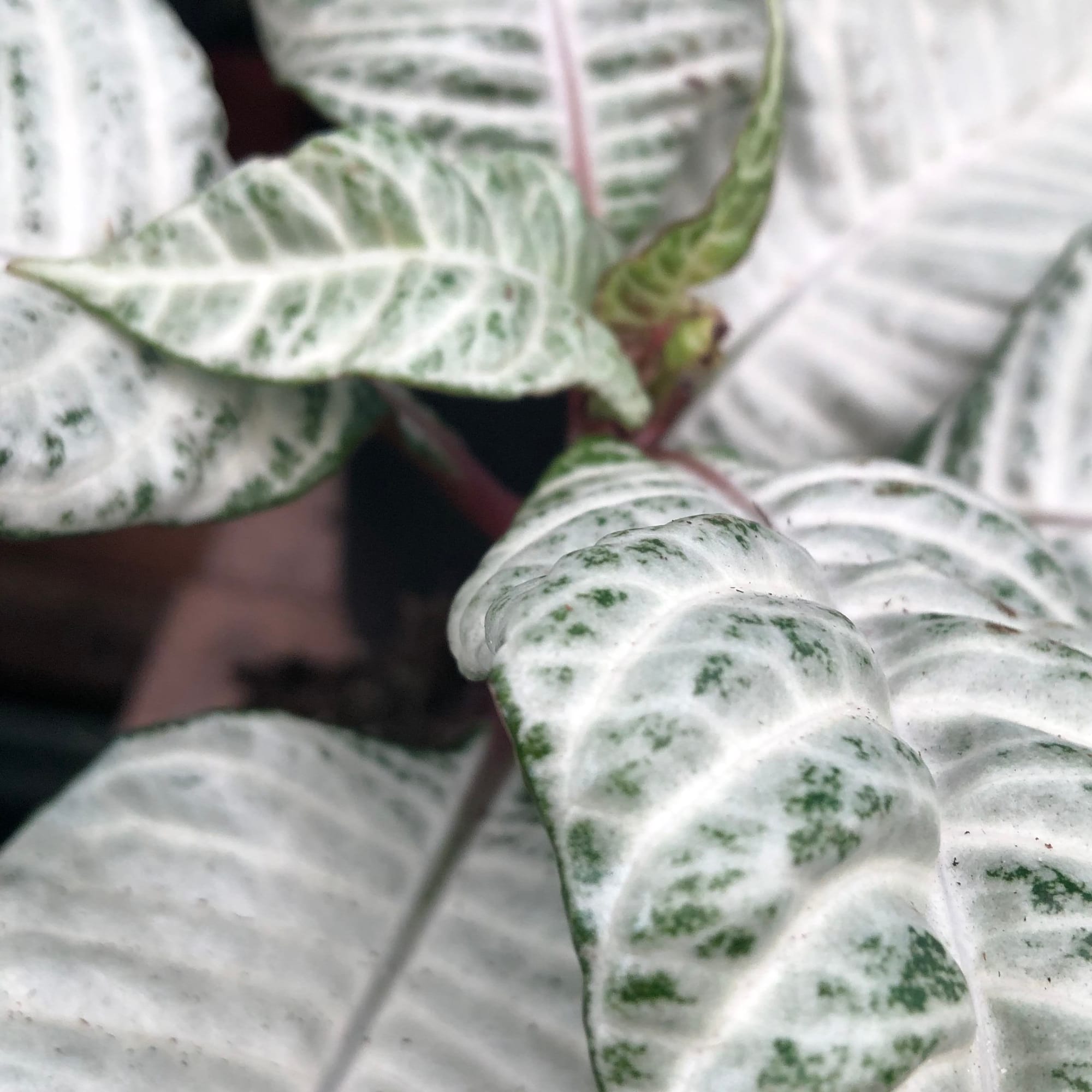 Aphelandra squarrosa 'White Wash'
Aphelandra squarrosa 'White Wash'
Flowers
As mentioned in 'Dormancy Care & Achieving Flowers', the actual flower will only last a few days; it's the yellow bracts which will provide the colour for several weeks. Swipe up to learn more about their flowers, and how to achieve a sensation bloom!
Repotting
Repot every two or three years in the spring, using a 'Houseplant' labelled potting mix and the next sized pot with adequate drainage. Aphelandra are far better potbound for several years due to the heightened risk of root rot and repotting-issues (like transplant shock) - so only repot if you feel it's wholly necessary.
Hydrate the plant 24hrs before tinkering with the roots to prevent the risk of transplant shock. For those situated in a darker location, introduce extra amounts of perlite and grit into the lower portion of the new soil to downplay over-watering risks. Click here for a detailed step-by-step guide on transplantation, or via this link to learn about repotting with root rot.
Book a 1-to-1 video call with THE HOUSEPLANT DOCTOR™ if you'd like a personal guide to repotting your houseplant. This will include recommending the right branded-compost and pot size, followed by a live video call whilst you transplant the specimen for step-by-step guidance and answer any further questions!
Pests & Diseases
Keep an eye out for mealybugs, aphids, spider mites, scale, thrips & whitefly. Common diseases associated with this species are root rot, red leaf-spot, heart rot, botrytis & southern blight - click here to learn more about these issues.
Toxicity
Not known to be poisonous when consumed by pets and humans. If large quantities are eaten, it may result in vomiting, nausea and a loss of appetite.
Retail Locations
Online Stores.
Book a 1-to-1 Call with THE HOUSEPLANT DOCTOR™
If you need further advice with your houseplants, book an advice call with ukhouseplants' friendly and expert writer today! This can be done via a video or audio call on most apps, including Facebook, FaceTime & Skype. A ten-minute call costs £6.95 (US$8), or £15.95 for thirty minutes. You can ask multiple questions, including queries on plants, pests, terrariums, repotting advice and anything in between. Please consider supporting this service to keep ukhouseplants thriving!